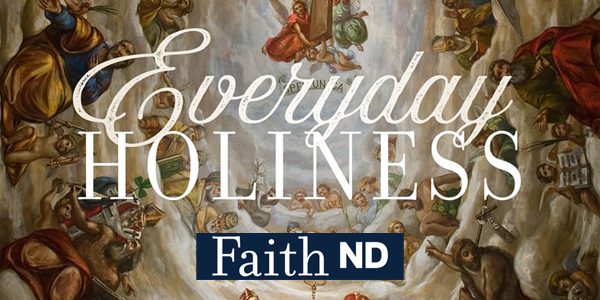Understanding the Body with W.B. Yeats & James Joyce – The Body & Mind
Subscribe to the ThinkND podcast on Apple, Spotify, or Google.
Featured Speakers:
- Declan Kiberd, Emeritus Donald and Marilyn Keough Professor of Irish Studies and Professor of English and Irish Language and Literature
- Deirdre Mulrooney, writer, filmmaker, radio documentarian, and dance historian
- Evanna Lynch, actress, podcaster, and activist
The opening session of the series Understanding the Body with W.B. Yeats and James Joyce was organized by Declan Kiberd, the Emeritus Donald and Marilyn Keough Professor of Irish Studies and a Professor of English and Irish Language and Literature at the University of Notre Dame. He was joined by Deirdre Mulrooney, an Arts and Humanities Creative Fellow at University College Dublin, and Evanna Lynch, an actress, podcaster and activist who danced in Mulrooney’s visual art performance of “Song of the Wandering Aengus”. The session was moderated by Lisa Caulfield, the Director of the Notre Dame Global Center at Kylemore Abbey. The three panelists discussed the art of Lucia Joyce, the daughter of the acclaimed Irish author James Joyce, namely the photographs of her in a fish costume which she wore for her performance at the international festival of dance in Paris in the late 1920’s. The artists also discussed her struggles with mental health and Mulrooney’s theory about the connection between Yeats and Joyce.
Kiberd began the session by giving an overview of the topics to be discussed throughout the series, emphasizing the importance of dance in highlighting the connection between the body and the mind. Kiberd then turned the attention to Lynch, asking her to explain the dance she took part in at Mulrooney’s request. Though Lynch was an accomplished dancer before being approached for Mulrooney’s production, the dance was a difficult one to learn. The dancing was shot almost completely from a sideways profile with an intense focus on perfection and precision. Because the inspiration for the choreography came from a series of still photos, Lynch had to concentrate on the shapes she made with her body throughout the dance, matching her body with the poses in the photos. Mulrooney then explained how she discovered her theory on the connection between Yeats and Joyce. As a knowledgeable historian, she was inspired by the photos of Lucia Joyce, the few remaining records of her work in existence. Through her continued research, she realized that the dates of Lucia’s dance lined up perfectly with the work of Yeats with the Abbey Theatre Ballet. The unique fish costume pointed her to the poem by Yeats that she strove to recreate in her production with Lynch, “Song of the Wandering Aengus.”
The three panelists then directed their focus to Lucia Joyce’s mental health. Though she was an amazing dancer and writer, her art has never been properly honored because of the shadow of her father, James Joyce, and the fact that she was held in mental asylums for a large part of her life. Mulrooney pointed out that although other artists of the time struggled with mental health as well, it was the women who were declared mentally ill and forced into mental facilities. Lynch expressed her opinion that if Lucia had lived in the modern day, she likely would’ve been able to live with her condition and have the language to talk about her struggles with mental health, if she even had a mental condition at all. Kiberd concluded the session by pointing out that the saddest part of Lucia Joyce’s story was that the doctors who tended to her in her final years did not believe she had a diagnosable mental illness. She was free to leave the mental facility she was being held in, but did not have a life to go back to or family that would welcome her back. Though she was an artist that likely would’ve been highly acclaimed in her day and in the modern day, her art wasn’t and never will be honored to the extent that her father’s is.
- Though the mind and the body are often thought of separately, thought should be a physical experience in addition to a mental one. (8:30)
- The female character in Yeats’ poem “Song of the Wandering Aengus” has so much life within her and is able to elude the control of others. Though they are trying to pin her down and understand her, they are unable to. (18:33)
- Artists need a creative outlet for their artistic energy. There are many examples throughout history of those who have struggled with mental health when this outlet was not available to them, including Lucia Joyce. (21:34)
- Mulrooney sought to replicate the art of Lucia Joyce in her creation of the dance to “Song of the Wandering Aengus. She tried to imagine what kind of dance she would’ve done. (35:03)
- In the 1920’s, artists didn’t have the language they needed to talk about mental health, especially female artists. This restricted their art and prevented them from having the freedom they needed to be creative. (46:03)
- “What we want to explore in this series is how much of their thinking about the freedom of the body and the connection of body and mind brings them together not only as artists but also as people who believed in what Yeats called ‘the thinking of the body’.” (Declan Kiberd, 7:41)
- “I just love that he is chasing after her and pursuing her and trying to pin her down and understand her but he never really gets there.” (Evanna Lynch, 18:33)
- “Creative people are often very fragile mentally. Usually men get away with it.” (Deirdre Mulrooney, 24:01)
- “Anyone who wants to be a great dancer looks for total mastery of the body. There’s no other dance background that I’ve found that gives you as much control over your body movement as ballet dancing.” (Evanna Lynch, 30:56)
- “We’re testing how much we can put ourselves out there, how much we can share of ourselves and still be taken seriously.” (Evanna Lynch, 44:02)
Related Content
Shannon Sharpe/Katt Williams, The Black Impact on the NFL Super Bowl & Taraji P Henson
In the first episode for Season 8, Isaiah and Tykiera talk about the Shannon Sharpe/Katt Williams Interview that took the internet by storm at the beginning of the year as well as...
watch videoEveryday Holiness: John Cavadini
Dr. John Cavadini, director of the McGrath Institute for Church Life and professor in the theology department at the University of Notre Dame, shares some of the hidden aspects...
View EventClimate Change and The Limits of Narrative
Join the Kellogg Institute for the introductory session of a workshop refining Kellogg Faculty Fellow Roy Scranton’s draft book project “Ethical Pessimism: Climate Change and...
View Event


